Turntable Buyer's Guide
Why Own a Turntable, Why Collect Vinyl?
There’s lots of reasons people cite for their record collection. From the very fastidious “It just sounds better” to the slightly perplexing “Because it’s very cool right now”. In most systems, that pure analogue signal path does sound better, and it is very cool, right now (or anytime). There’s lots of reasons for the sound quality and character of vinyl, but I’ll leave that explanation to the people with whiteboards and oscilloscopes.
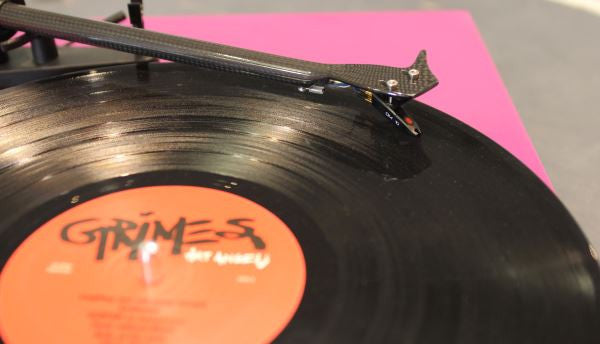
There’s another reason for collecting vinyl that I find dear to my heart. That’s the physical connection to my music. Streaming has won. We don’t own music anymore. We just pay a couple of bucks a month and we have access to the entire history of human kind’s music (or what eve is allowed by the licensing agreements). That’s functionally wonderful. But it’s also sterile. There’s nothing that you can hold. There’s no trophy to display your love for a particular piece of music. A record collection doesn’t have to be your entire music library, but when you want to really listen to an album, when you want to celebrate the music, a black vinyl disc is what you need.
Importantly, unlike your Spotify favorites list, you can’t hit random on your turntable and accidentally reveal the 1998 Spice Girls B Side that is your guilty pleasure song.
There is just something magical about the tactile ceremony of putting a record on. Pull it from its slipcover, find the right side, line it up on the platter, start the turntable spinning, and then, ever so carefully, drop the needle. It’s an experience.
To get the best out of that beautiful vinyl, you’re of course going to need a turntable. This is the machine that you skillfully operate when it’s time to put some music on. It needs to be interacted with to use it, so it’s got to be something on show. The turntable itself is an ornament, a bit of furniture in your house. In a big old school hifi stack, a turntable always has pride of place on the top shelf. In a more minimalist sound system, your turntable is still out and on display. So your turntable not only needs to sound right, it’s best if it fits into the rest of your house too. Thankfully, there are a massive amount of turntables to suit all manner of functions, looks and budgets.
Good Vibrations (and the bad).
We all know a turntable turns. It’s right there in the name. At it’s absolute bare basics though, a turntable is a vibration control machine. A good turntable extracts the vibrations generated by a diamond stylus in a records groove, and then converts that vibration into the signal that will eventually become your music. The other very important, and often overlooked function of a turntable, is to get rid of unwanted vibrations that would otherwise interfere with that signal.
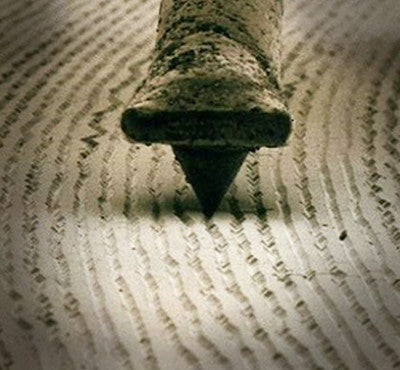
These might be external vibrations: People walking by, the fridge vibrating gently in the next room, your drunk mate slamming a palm on the other end of the bench for emphasis while lecturing you about something unintelligible. A good turntable generally gets rid of these by absorbing them before they reach the record and needle. Dense rubber feet underneath the turntable, heavy weight base materials, decoupling parts of the turntable from one another, and many other methods are used to keep those unwanted forces out.
The other source of vibrations is internal. We don’t live in a 8th grade physics class, so we have to take friction and other unpleasant things into account. The motor that spins the platter generates a small hum. The bearing upon which the platter spins will generate a tiny bit of friction noise.The turntable will have certain resonances that it will pick up. There are a number of ways a good turntable fights these. Suspending the motor off the main plinth. Using a belt drive system (more on that later), using the highest quality materials and manufacturing possible (within reason it’s hard to justify a $200 precision made bearing on a $429 turntable).
The other way to minimise internal noises, is to reduce any unnecessary stuff in the turntable. This is why many ProJect turntables use a manual speed change method. To change between a 33 RPM and a 45 RPM record, you’ll need to physically change where the belt sits on its motor spindle. This seems like a hassle, until you’ve done it 3 times and find out that it’s easy, and when you realise that most 45s are singles that you’re never going to listen to anyway. The benefits of this manual change are pretty significant though. There’s a whole gearing mechanism that can be stripped out of a turntable. That’s a massive source of noise removed, and your music improved.
Of course, if you want speed change at the touch of a button, there are models that can do that for you with a very clever and silent electronic control.
Identifying the Parts of Your Turntable
The vocabulary of a turntable can be confusing, even before you’ve started to read HiFi press talking about “bright” or “throaty” sound. It can seem impenetrable, but there’s no need for an engineering degree to understand what it all does. Here’s a quick breakdown of the major parts of a turntable, what they’re called, and what they do.

Platter
This is the bit that actually spins! It’s where you put your record. Depending on the material the platter is made of, there will often be a platter mat, sometimes called a slipmat. The mat provides even more noise isolation, and a soft surface for you vinyl to sit on. There are many optional kinds of platter and mat material that can be added to your turntable.
The Plinth
The base of your turntable. Like your slightly scary nana at a rapidly degrading family reunion, it’s what holds everything together. Unlike old nan, the plinth often includes all manner of vibration isolating systems. This could be dense rubber feet, various internal decouplings, or many other methods.
The Tonearm
Arguably the most important part of the turntable. The tonearm is what gets your stylus into the record’s groove, and guides it through it’s entire journey from the outer rim to the leadout groove at the centre. A tone arm has all the clever mechanisms for making sure your stylus sits just right. It must be balanced, aligned correctly, adjusted for height, etc. A good tone arm moves freely with no resistance, but only exactly as it’s supposed to. It should be long and rigid, but also light and compact. A tonearm is a very careful balancing act to make sure many conflicting priorities are catered to. Pro-Ject get around many of these conflicts by using carbon fibre to make superior arms.
The counterweight
This is a circular hunk of metal that sits at the back of your tonearm. It’s sole job is to balance out the weight of the entire arm so that there is just the right amount of weight on the stylus.
The anti skate weight
It’s got nothing to do with authoritarian local councils taking issue with kids on boards. It’s a little dangling weight on a fishing line that provides a little touch of lateral force to make sure the stylus sits perfectly in the centre of the groove as the record spins. It stops the arm skating across the record.
The motor
Not a fancy word, just the bit that makes the turning happen on the turntable. The motor pulley is where your belt sits will usually determine the speed that your vinyl spins at.
The Belt Drive
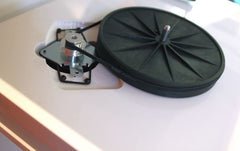
All Pro-Ject turntables are belt driven turntables. In a mechanical sense, this means that the motor spins a belt that is connected to the platter of your turntable. The alternative design, is what’s called a “direct drive” turntable. This is where the motor is directly connected to the platter. Every electric motor in existence vibrates, grinds a little bit, or in some other way gives off some noise of some kind.
For sheer sound quality, the belt drive design is better in all respects. The belt itself acts as a dampening method, separating the noise of the motor from the platter. The trade offs are minimal. Your turntable will take an extra 5 or so seconds to spin up to speed. You may have to replace the belt every 5 years or so. And you can’t scratch like a DJ.
Direct drive turntables are more often seen in the pro world or on terrible low budget domestic turntables pretending to be a pro turntable. On pro turntables, this is helpful for start and stop times when scratching or beat matching. The downside is that noisy motor is directly connected to the platter where your record sits. Feeding noise right into your stylus.
For a very small compromise, Pro-Ject belt driven turntables are the better choice for smooth home listening.
Stylus, Cartridge or Needle?
What do you call the pointy bit that sits in the record groove? The term needle gets used a lot, but it’s not really correct anymore. It was virtually a metal needle when shellac 78 RPM records graced gramophones in the 1890s.
These days, we use a diamond stylus. The entire device that gets attached to the front of the of your tonearm is the “cartridge”. This is the stylus, and the engine behind it that generates a signal out of the stylus’ movement.
The term “stylus” technically refers to the actual microscopic bit of diamond that reads the groove. In most real world situations, it refers to the entire replaceable part at the front of the cartridge assembly.

There is a huge variety of different styli out there. The major differences that make for improvements in quality of stylus, are the shape, or “profile” of the diamond, and the type of engine used. There’s also differences in materials and many other factors to take into consideration.
The most common diamond profile is spherical. It presents a simple circle to the groove, it’s cheap and easy to make, but that fat circle misses out on a lot of the finer parts of the groove, so your music ends up with less overall information. Elliptical styli are the next step up, and are a much better design. They get into more of the grooves finer undulations and read more of the music, more of the detail. There cuts of diamond go up and up, getting finer, and more precise as the range goes up.
You may also hear about “nude” diamonds. This isn’t as rude as it sounds. It simply means that your stylus is pure diamond, rather than a “tipped” stylus, which has a small bit of diamond on the end of a metal nub. A nude diamond is much more accurate in its transfer of vibration.
Finally, you’ll hear about Moving Magnet and Moving Coil cartridges. MM or MC. MM are the most common type of cartridge. It’s almost all you’ll ever see until you start to get into the esoteric world of hobby HiFi.
On a Moving Magnet cartridge, the diamond is attached to a lever, at the other end is a magnet which is surrounded by coils. This magnet moves around as the diamond vibrates, and generates our signal. Simple high school physics and engine/generator design.
On a Moving Coil, there is a coil on the end of the lever, surrounded by magnets. A simple change, but a coil is much lighter, meaning the stylus can move faster, change directions faster and be more accurate in its read of the record. The big ever present “but” is that a moving coil cartridge is much harder to make, so they’re more expensive, and they output a lower signal, so they require a specific kind of phono preamplifier. Which leads us to...
Phono Stage
A turntable is a very physical format. In simple terms, the signal coming from your turntable is generated by nothing more than the tiny diamond stylus vibrating in the groove of the record. The grooves aren’t even as much as half a millimetre across. The signal that your turntable generates is absolutely tiny. Electrically, it’s almost nothing. That miniscule signal has to be amplified. You’ll need what’s called a Phono Pre Amplifier, or a Phono Stage. Two terms for the same thing. It’s a very important part of the turntable system, but one that’s often overlooked.
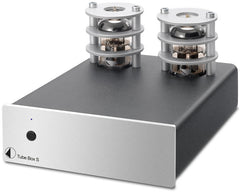
It takes the millivolts from the turntable, and ups them to volts that a sound system can recognise. Ratio wise, this is more amplification than at any other stage in your sound system. So, like expanding an image, the quality is very important. It’s worthwhile getting a good quality external phono stage if you can.
Some turntables are available with the phono stage already built in. This is perfect if you’ve got a set of powered speakers, or an existing mini sound system of some kind that you just want to add a turntable to.
Some sound systems have the phono stage already built in. This is common on HiFi amplifiers, but it’s not available on all of them. If you’re looking for an amplifier, check to see if it’s got that phono stage built in.
The best way is to use an external phonostage. It’s a small extra box you’ll need to find a home for, but it’s the easiest way to get a really high quality solution. You feed your turntable into the phono stage, it amplifies the signal, and then feeds it out to your sound system. A high quality phono stage will isolate and reject any interference, which can be a big problem when dealing with such small signals. It will also improve the quality of audio output to your sound system. Some phono stages will even let you calibrate them to the specifications of the stylus you are using, making sure that you sound is crisper, more accurate and more enjoyable than ever.








